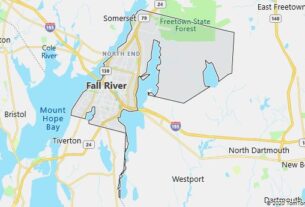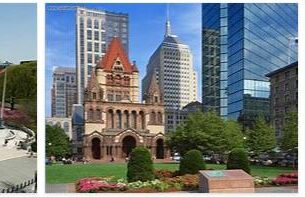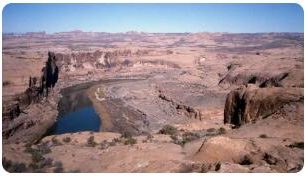Urbanism in the Southern States
The Piedmont of the Appalachians is also well populated, with industrial cities serving as focal centers of agricultural areas occupied by plantations (tobacco, cotton), such as Charlotte in North Carolina, Richmond in Virginia and especially Atlanta, capital of Georgia, with a range now very large in manufacturing activities and equipped with an active airport, considered the busiest in the world. In the extreme south-east of the country, Florida boasts famous tourist resorts, starting with luxurious Miami, a seaside and climatic resort, especially in winter. Even in the Mississippi Valley, the always vital artery of the USA, there are large urban centers such as Minneapolis in Minnesota, Saint Louis in Missouri and Memphis in Tennessee. Highly industrialized, they also have very important functions of connection between East and West, as well as between North and South, of the Great Plains; this is especially true for Saint Louis, an important river port on the Mississippi, the country’s railway hub and an ancient base for penetration towards the West., favored by its location at the confluence of Missouri with Mississippi. The entire south-central area of the Great Plains has its natural outlet in New Orleans, a French port of foundation at the mouth of the Mississippi, which has grown enormously to become one of the largest in the USA, although the golden age for the city was that of great river navigation. The shore overlooking the Gulf of Mexico is undergoing great expansion, especially on the Texan coast connected to the most inland oil and agricultural areas, dominated by the new metropolises of Dallas and Houston, a very lively city, ultramodern US capital for the petrochemical industry, as well as fifth port of the country connected by a canal approx. 60km to Galveston Bay. Houston has significantly increased its population in recent years; but the whole Texan area facing the Gulf records population growth among the highest in the USA. United States is a country located in North America according to COMMIT4FITNESS.COM.
Urbanism in the Western States
With the meridian of 100 °, which marks the transition to semi-arid conditions, we can say the West begins, still sparsely populated, with a few isolated cities, focal points of large territories but whose web of economic relations is generally much less than that of the centers of the East, although they are in full industrial expansion. This is especially the case of three cities, capitals and major centers of the states of Colorado, Utah and Arizona respectively: Denver, located at the foot of the Rocky Mountains, developed as a supply base for the nearby mining towns, still a great hub of communications and intense commercial center, favored by the foothill position, facing the Central Plains, with various industries mainly linked to the agricultural sectors, Salt Lake City, founded by the Mormons as an agricultural center, but today the main seat of industrial and mining activities; Phoenix, very lively for trade, traffic and, thanks to the excellent climate, tourism, but whose economy increasingly depends on various light industries, in particular electronics, air and aerospace, characterized by high technologies. However, the new and most promising population areas of the entire country are those facing the Pacific. This is where the alternative to the Atlantic megalopolis is being born, even if the environmental and geographical conditions are different. California was and still is the promised land (so much so that it is said that the future of the USA begins here): its population growth, which is greater than the national one, is incessant. Oil has been one of the factors in the fortunes of this state; but other causes also played a part, such as the expansion of US interests towards the Pacific, the mild climate and the favorable conditions for the birth of light, technologically advanced industries, less linked to mineral sources, especially coal.
San Francisco (whose metropolitan area includes, among other things, the important center of Oakland) was the first large city to rise on the Pacific shore and has inextricably linked its name to the whole epic of the conquest of the West, in particular the “gold rush”; its great development began in the second half of the last century, after the transcontinental rail link, but San Francisco had to start a new life almost after the disastrous earthquake of 1906, which almost entirely destroyed it. In very recent and dizzying expansion, so much so that it can be defined as the great rival of New York, is Los Angeles (its metropolitan area includes numerous centers such as Long Beach, Pasadena, Glendale etc.), magnified with the spread of motorization. Vast, extending over a radius of over 50 km, eminently “horizontal” – in this completely opposite to New York, “vertical” and centripetal within the Hudson Bay – it is urbanistically unique in the world, densely occupied by motorways, junctions and road links of all sorts, almost a city in constant motion; the metropolis naturally has a powerful commercial activity (the port is constantly growing and the airport is the busiest commercial hub on the continent and among the largest in the world), with grandiose complexes especially in the aeronautical and aerospace sector, for which Los Angeles excels in the country, as well as being, thanks to the suburb of Hollywood, the capital of cinema. The metropolis, hit in 1994 by a disastrous earthquake, has, directly or indirectly, influenced the economic and demographic development of a vast area of Southern California, which includes other major centers such as San Diego, Anaheim, San Bernardino. The last US area of considerable population is the North-West, especially in the area that gravitates to Seattle – Tacoma in the state of Washington, a large industrial center, home, among other things, of Boeing, the largest aviation industry in the world, as well as a very active port on the ‘Pacific Ocean.



